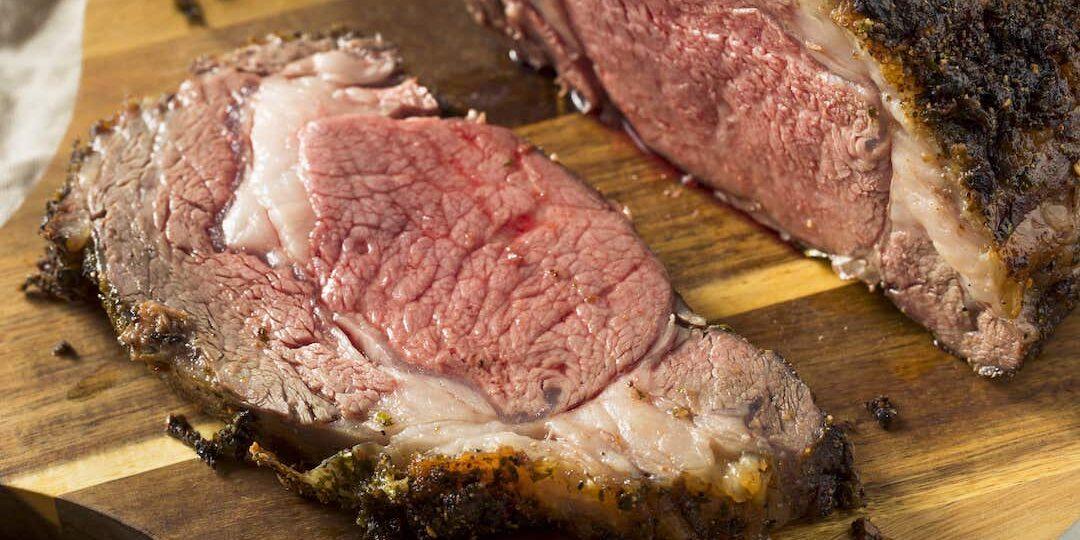
Do you want flavor and succulence? Prime Rib on the grill delivers every time I’ve made it. Prime Rib, also known as a standing rib roast, has an eye of meat and fat marbling, which keeps it juicy This cut comes from (wait for it) the rib section of the cow, an area where muscles don’t get worked heavily, improving tenderness.
A whole prime rib weighs in at between 12-16 pounds (sounds good to me!). You need approximately one pound of bone-in Prime Rib per person, or on average, two bones. Make mine three, please.
Prime Rib is a cut of special meat in that people often associate it with holidays, so don’t skimp. Get the USDA Grade of “choice” or “prime.” You might also consider Kobe. Yes, it’s a little more expensive, but it’s worth it.
Prime Rib Primer
There are a lot of ways to prepare prime rib from cooking it in the oven or even sous vide. However, before you start, there are a few things you need to know.
Shopping for Prime Rib
We suggest going to a butcher where you can see the ribs clearly, and request as many or as few as you wish. Here are some facts to consider:
- Cows have 13 ribs on each side.
- A standing rib roast can weigh as much as 25 pounds, so it’s not uncommon to have it cut in half.
- The second cut of ribs is near the shoulder of the cow, and has big sections of fat. These require slow cooking for best results.
- The first cut of ribs comes from the hind of the of the roast near the loin section. These are leaner and more tender.
Prepping the Prime Rib
Once you’ve got your Prime Rib home, it’s time to get to work. There are four steps in the preparation process before you proceed to grilling (some are optional).
1. Removing the sinew or membrane (silver skin) from the underside of the ribs.
It’s ropy and tough when cooked, and also doesn’t let the smoke penetrate your meat as well. Flip the ribs upside down. Gently loosen the silver skin using a knife down the length of the ribs on both sides. At the wide end, grab the loosened sin with a paper towel and tear it right off. The paper towel keeps your hand from slipping.
2. Frenching the Bones
Frenching Prime Rib bones is not a necessary step, but it makes for a lovely presentation. What is it? Frenching means cutting the meat away from the end of a rib, leaving a bit of bone exposed. Some people get really fancy and put frilly paper over the exposed bones, but you don’t have to go that far.
To be honest, it’s a rather labor-intensive project. If you decide to embark on Frenching, you’ll need a sharp knife and a decent cutting board. Here’s a visual aid.
On the other hand, you could just leave it to your butcher so you can get to the smoker sooner!
3. A last Minute Trim
This is another optional preparation method grillers like because they can get the dry rub all over each rib. Slice gently between each bone part way down. Take care not to completely separate the ribs (that would kinda spoil the total effect). Now when you apply your rub, you can get it in between each section.
TIP: I use butcher twine after trimming. This keeps the ribs secure.
4. There’s the Rub
You want to apply your chosen rub a full four hours before you smoke your prime rib. Make sure you take it out of the refrigerator beforehand, so it gets to room temperature. This makes your meat cook more evenly.
Some common components to a Prime Rib rub include:
- Brown sugar
- Garlic
- Onion powder
- Orange zest
- Oregano
- Paprika
- Rosemary
- Thyme
Let’s get Grilling!
When you want the tenderest Prime Rib, you want to cook it over indirect heat at about 250F. Place its fat side up on the grill, letting all that melty goodness go into the meat. When your meat reaches 100F, it’s time to create a crust (on average it takes 2 hours).
Turn up the grill to 400F. Leave the Rib right where it is. When the Roast reaches 125F (for medium-rare; 135F for medium) it’s time to give the meat a chance to rest for 30 minutes (hey, it’s been a long day).
No matter how tempting, do not cut into it right away or you lose juices to your cutting board. Don’t worry, the meat won’t get cold. It actually increases in temperature between 5-10 degrees as it sits.
Pit Master’s Memo: Prime Rib vs. Ribeye
What’s the difference between a Prime Rib and a Ribeye? They are similar meats, but not completely the same. What they do have in common is tons of flavor and a fantastic temperature. Plus, they both come from the same part of the animal.
Ribeye is the best part of the ribs. Since it’s smaller, the Ribeye is typically cooked as a steak (bone-in or out). It’s a much faster cut of meat for grilling or frying in a cast-iron pan. You can get a beautiful sear too. All told, it takes about 6 minutes total in a pool of butter.
Prime Rib takes longer. It benefits from low temperatures to bring out the best flavor profile. You can still get a good crisp on it, so you don’t lose texture. Seasonings for a Prime Rib are typically more plentiful, so they get into each bite.